Formation Orders of Battle are as of the start of the war or when created. It was not uncommon for units to change roles and/or formations. Each divisional formation would also have assets assigned to them from the supporting branches. This would include but may not be limited to: Royal Canadian Artillery, Anti-Tank Regiment, Light Anti-Aircraft Regiment, Corps of Royal Canadian Engineers, Royal Canadian Corps of Signals, Royal Canadian Army Service Corps, Royal Canadian Army Medical Corps, Royal Canadian Ordnance Corps, Royal Canadian Electrical and Mechanical Engineers, Canadian Postal Corps, Canadian Provost Corps, and Canadian Intelligence Corps. These have been left out of the Orders of Battle for brevity.
On 17 July 1940, the British VII Corps was reformed (it was active during the First World War) in order to defend against an anticipated German invasion. Its area of operations was south east England in the counties of Surrey, Kent, Sussex, and Hampshire. The corps consisted of 1st Canadian Infantry Division, 1st Canadian Armoured Division, and the 2nd New Zealand Expeditionary Force (a division sized infantry force). The corps was commanded by Maj-Gen Andrew McNaughton.
On 25 December 1940, it was renamed the Canadian Corps.
Commanders

General Andrew George Latta McNaughton CH CB CMG DSO CD PC (25 February 1887 – 11 July 1966)
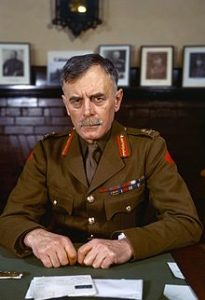 McNaughton was born in Moosomin, Saskatchewan but moved to Quebec later in live to attend Bishop's College School and then McGill University. He received degrees in Physics, Engineering, and Electrical Engineering before becoming a Professor of Engineering.
McNaughton was born in Moosomin, Saskatchewan but moved to Quebec later in live to attend Bishop's College School and then McGill University. He received degrees in Physics, Engineering, and Electrical Engineering before becoming a Professor of Engineering.
He joined the Militia in 1909 and by 1914 commanded the 3rd Field Battery in Montreal.
He served throughout the First World War. He was wounded twice and mentioned in dispatches three times. By the end of the war (at the age of 31), he was promoted to Brigadier General and commanded all Canadian Artillery.
He was known as a scientific gunner and introduced detection techniques such as sound and flash ranging. He invented a technique for the measurement of barrel wear and integrating that into aiming. He also introduced techniques for precision targeting and the creeping barrage.
After the war, McNaughton joined the permanent forces. He was a member of the Otter Commission and was instrumental in moving the PPCLI and the Royal 22nd Regiment to the permanent forces. He did not stop his science interests and developed the Cathode Ray Direction Finder (a fore-runner of RADAR) and employed it for aerial mapping of Canada's north.
McNaughton left the military and headed the National Research Council of Canada from 1935 to 1939.
At the start of the Second World War, McNaughton rejoined the Military and commanded 1st Canadian Infantry Division. In July 1940, British VII Corps was created to defend England from the threat of German Invasion. In December 1940, 1st and 2nd Canadian Infantry Corps join together to become the Canadian Corps. McNaughton commands this until November 1941. With the influx of Canadian forces into England, Canadian Corps became I Canadian Corps and a new II Canadian Corps was created - the two became the 1st Canadian Army commanded by McNaughton.
McNaughton was adamant that the 1st Canadian Army should fight as a single unit and not be broken up. This caused many issues and in December 1943, McNaughton is removed from command and returns to Canada.
After a short stint as the Minister of National Defence (1944 - 1945), McNaughton chaired the United Nations Atomic Energy Commission from 1946 to 1948; served as Canada's Ambassador to the United Nations from 1948 to 1949; and chaired the Canadian Section of the International Joint Commission from 1950 to 1962.
Once there was enough of a Canadian military presence in England, a Corps formation was created for administrative purposes. It was officially created on 25 December 1940 and was composed of 1st and 2nd Canadian Infantry Divisions. Its primary concern was the training of Canadian forces. Canadian Corps was commanded by Maj-Gen McNaughton until replaced by Maj-Gen Peakes in November 1941. Canadian Corps was re-designated as I Canadian Corps on 6 April 1942 as a part of the 1st Canadian Army.
Commanders

General Andrew George Latta McNaughton CH CB CMG DSO CD PC (25 February 1887 – 11 July 1966)
 McNaughton was born in Moosomin, Saskatchewan but moved to Quebec later in live to attend Bishop's College School and then McGill University. He received degrees in Physics, Engineering, and Electrical Engineering before becoming a Professor of Engineering.
McNaughton was born in Moosomin, Saskatchewan but moved to Quebec later in live to attend Bishop's College School and then McGill University. He received degrees in Physics, Engineering, and Electrical Engineering before becoming a Professor of Engineering.
He joined the Militia in 1909 and by 1914 commanded the 3rd Field Battery in Montreal.
He served throughout the First World War. He was wounded twice and mentioned in dispatches three times. By the end of the war (at the age of 31), he was promoted to Brigadier General and commanded all Canadian Artillery.
He was known as a scientific gunner and introduced detection techniques such as sound and flash ranging. He invented a technique for the measurement of barrel wear and integrating that into aiming. He also introduced techniques for precision targeting and the creeping barrage.
After the war, McNaughton joined the permanent forces. He was a member of the Otter Commission and was instrumental in moving the PPCLI and the Royal 22nd Regiment to the permanent forces. He did not stop his science interests and developed the Cathode Ray Direction Finder (a fore-runner of RADAR) and employed it for aerial mapping of Canada's north.
McNaughton left the military and headed the National Research Council of Canada from 1935 to 1939.
At the start of the Second World War, McNaughton rejoined the Military and commanded 1st Canadian Infantry Division. In July 1940, British VII Corps was created to defend England from the threat of German Invasion. In December 1940, 1st and 2nd Canadian Infantry Corps join together to become the Canadian Corps. McNaughton commands this until November 1941. With the influx of Canadian forces into England, Canadian Corps became I Canadian Corps and a new II Canadian Corps was created - the two became the 1st Canadian Army commanded by McNaughton.
McNaughton was adamant that the 1st Canadian Army should fight as a single unit and not be broken up. This caused many issues and in December 1943, McNaughton is removed from command and returns to Canada.
After a short stint as the Minister of National Defence (1944 - 1945), McNaughton chaired the United Nations Atomic Energy Commission from 1946 to 1948; served as Canada's Ambassador to the United Nations from 1948 to 1949; and chaired the Canadian Section of the International Joint Commission from 1950 to 1962.

Major General George Pearkes, VC, PC, CC, CB, DSO, MC, CD, OD (February 28, 1888 – May 30, 1984)
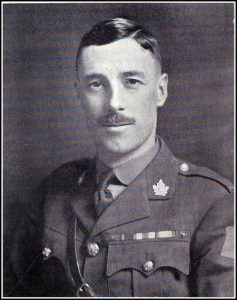 Pearkes was born in Watford, Hertfordshire, England. In 1906, he and his brother came to Canada, and lived near Red Deer. In 1911, he joined the North-West Mounted Police in the Yukon.
Pearkes was born in Watford, Hertfordshire, England. In 1906, he and his brother came to Canada, and lived near Red Deer. In 1911, he joined the North-West Mounted Police in the Yukon.
In 1915, he joined the 2nd Canadian Mounted Rifles and then the 5th Canadian Mounted Rifles in 1918. During the war, he was wounded at least 4 times.
At the Battle of Passchendaele, Pearkes was a 29 year old Acting Major when his actions (while wounded) during an attack saw him awarded the Victoria Cross. By the end of the war, he had been promoted to lieutenant colonel and had been awarded the DSO and MC as well.
Between the wars, Pearkes stayed in the permanent forces as a member of the PPCLI in western Canada - commanding the 13th Military District (Calgary) from 1938 to 1940.
In 1940, Pearkes took command of the 2nd Canadian Infantry Brigade and went to England as part of 1st Canadian Infantry Brigade.
In November 1941, Pearkes took temporary command of the Canadian Corps when McNaughton returned to Canada due to ill health. He commanded the Corps until Gen Harry Crerar assumed Corps command in April 1942. In August 1942, he returned to Canada to head up Pacific Command. He retired from the Army in February 1945 when he was not granted a change of command.
From 1945 to 1960, he was active in Federal politics eventually serving as Minister of National Defence to PM John Diefenbaker. Notably, it was his recommendation to cancel the AVRO Arrow program.
He also served as Lieutenant Governor of British Columbia from 1960 to 1968.
As of 1942, there were 5 Canadian Divisions and 2 independent tank brigades established in England. At that point, a Canadian Army formation was created from the Canadian Corps. Other than the Dieppe raid, the Army’s focus was on preparing for the defense of England.
The Army was split into two corps formations. To support the Mediterranean campaign; I Canadian Corps was sent to Sicily and Italy while II Canadian Corps was active in D-Day.
The 1st Canadian Army did act as a combat formation in North-west Europe after the completion of the Italian Campaign.
1st Canadian Army was disbanded on 20 Jun 1946.
Commanders

General Andrew George Latta McNaughton CH CB CMG DSO CD PC (25 February 1887 – 11 July 1966)
 McNaughton was born in Moosomin, Saskatchewan but moved to Quebec later in live to attend Bishop's College School and then McGill University. He received degrees in Physics, Engineering, and Electrical Engineering before becoming a Professor of Engineering.
McNaughton was born in Moosomin, Saskatchewan but moved to Quebec later in live to attend Bishop's College School and then McGill University. He received degrees in Physics, Engineering, and Electrical Engineering before becoming a Professor of Engineering.
He joined the Militia in 1909 and by 1914 commanded the 3rd Field Battery in Montreal.
He served throughout the First World War. He was wounded twice and mentioned in dispatches three times. By the end of the war (at the age of 31), he was promoted to Brigadier General and commanded all Canadian Artillery.
He was known as a scientific gunner and introduced detection techniques such as sound and flash ranging. He invented a technique for the measurement of barrel wear and integrating that into aiming. He also introduced techniques for precision targeting and the creeping barrage.
After the war, McNaughton joined the permanent forces. He was a member of the Otter Commission and was instrumental in moving the PPCLI and the Royal 22nd Regiment to the permanent forces. He did not stop his science interests and developed the Cathode Ray Direction Finder (a fore-runner of RADAR) and employed it for aerial mapping of Canada's north.
McNaughton left the military and headed the National Research Council of Canada from 1935 to 1939.
At the start of the Second World War, McNaughton rejoined the Military and commanded 1st Canadian Infantry Division. In July 1940, British VII Corps was created to defend England from the threat of German Invasion. In December 1940, 1st and 2nd Canadian Infantry Corps join together to become the Canadian Corps. McNaughton commands this until November 1941. With the influx of Canadian forces into England, Canadian Corps became I Canadian Corps and a new II Canadian Corps was created - the two became the 1st Canadian Army commanded by McNaughton.
McNaughton was adamant that the 1st Canadian Army should fight as a single unit and not be broken up. This caused many issues and in December 1943, McNaughton is removed from command and returns to Canada.
After a short stint as the Minister of National Defence (1944 - 1945), McNaughton chaired the United Nations Atomic Energy Commission from 1946 to 1948; served as Canada's Ambassador to the United Nations from 1948 to 1949; and chaired the Canadian Section of the International Joint Commission from 1950 to 1962.

Lieutenant General Kenneth Stuart CB DSO MC (September 9, 1891 – November 3, 1945)
 Kenneth Stuart was born in Trois-Rivières, Quebec, Canada.
Kenneth Stuart was born in Trois-Rivières, Quebec, Canada.
Stuart graduated from the Royal Military College of Canada in 1911.
He served with the Royal Canadian Engineers during the First World War.
He instructed at the Royal Military College of Canada after the war until 1938 when he became Director of Military Operations & Intelligence.
He began service in the Second World War as Commandant of the Royal Military College of Canada. He was made Deputy Chief General Staff in 1940, Vice Chief General Staff in 1941 and then Chief of the General Staff later that year.
In December 1943 he was appointed Acting Commander of the 1st Canadian Army in England until transferred in March 1944 to Chief of Staff at Canadian Military Headquarters in England.

General Henry Duncan Graham "Harry" Crerar CH, CB, DSO, CD, PC (April 28, 1888 – April 1, 1965)
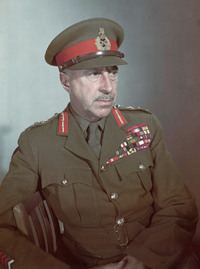 Harry Crerar was born in Hamilton, Ontario and attended Upper Canada College and Royal Military College of Canada.
Harry Crerar was born in Hamilton, Ontario and attended Upper Canada College and Royal Military College of Canada.
Crear joined the artillery in 1910 and rose to the rank of lieutenant-colonel of artillery in the First World War. After the war, he stayed in the military.
He held a number of staff positions during the interwar years, including Commandant of the Royal Military College of Canada in 1939.
At the beginning of the Second World War, Crerar held primarily staff positions until the end of 1940 when he became Chief of the General Staff. He commanded 2nd Canadian Infantry Division from 1941 until April of 1942 when he took command of I Canadian Corps. In November of 1942, he commanded I Canadian Corps in Italy.
In March 1944, he rose to command 1st Canadian Army which also contained British and Polish units including the Polish 1st Armoured Division.
In early 1944, the 3rd Canadian Infantry Division and 2nd Canadian Armoured Brigade participate in the assault phase of the Normandy landings as part of British I Corps. II Canadian Corps became complete in July 1944 when the 2nd Canadian Infantry Division landed.
1st Canadian Army HQ was established in Europe in July 1944. With I Canadian Corps in Italy, 1st Canadian Army did not become complete until the April 1945 when I Canadian Corps moved from Italy to Europe as part of Operation Goldflake.
He was made a full General in November 1944. Crerar returned to Canada in 1945 and retired in 1946.
After the war, he became a diplomat and represented Canada in Czechoslovakia, Japan, and the Netherlands.

Lieutenant-General Guy Granville Simonds, CC, CB, CBE, DSO, CD (April 23, 1903 – May 15, 1974)
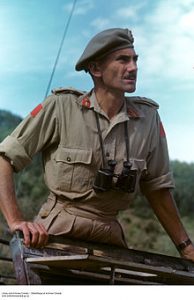 Guy Simonds was born in Ixworth, near Bury St Edmunds, Suffolk, England to a military family. His family emmigrated to British Columbia in 1911. His father enlisted for World War 1 and was wounded in 1918; released with the rank of Colonel. The war was hard on the family and Simonds has to leave school to work,
Guy Simonds was born in Ixworth, near Bury St Edmunds, Suffolk, England to a military family. His family emmigrated to British Columbia in 1911. His father enlisted for World War 1 and was wounded in 1918; released with the rank of Colonel. The war was hard on the family and Simonds has to leave school to work,
He attended the Royal Military College of Canada in Kingston, Ontario and at graduation he was awarded the Sword of Honour for t0p candidate in 1925.
He commissioned in 1926 into the Royal Canadian Horse Artillery. He attended the Gunnery Staff Course (1932) and then Staff College (1936) in England. Newly a Major, he instructed at the Royal Military College of Canada in Artillery and Tactics.
At the start of World War 2, he was a staff officer with the 1st Canadian Infantry Division but left to command the 1st Field Regiment, Royal Canadian Artillery. After a stint as the commandant of the Canadian Junior War Staff Course in November 1940, he joined 2nd Canadian Infantry Division as a staff officer. In August 1941, he was made acting Brigadier General Staff of I Canadian Corps until mid-July 1942.
In September 1942, he was made commander of the 1st Infantry Brigade in 1st Canadian Infantry Division.
In April 1943, Simonds was promoted to major-general and commander of 2nd Canadian Infantry Division, This position was short lived as nine days later, he was transferred to command the 1st Canadian Infantry Division, replacing Major-General Harry Salmon who had died in a plane accident. He led the 1st Canadian Division through Sicily and then Italy. At 40, he was the youngest Canadian officer to lead a division in action.
In September 1843, Brigadier Christopher Vokes replaced Simonds as commander of the 1st Canadian Division due to illness. Upon recovery, he took command of the 5th Canadian (Armoured) Division in November 1943.
In January 1944 he was recalled to the United Kingdom to take command of II Canadian Corps. It was claimed at the time that Simonds was the youngest corps commander in the British Empire. As part of his taking over, many older officers such as F. F. Worthington (commander of 4th Canadian Armoured Division) were removed.
Once II Corps was activated, Simonds would direct four major attacks during the Battle of Normandy. In September 1944, Simonds temporarily took charge of the First Canadian Army from Lieutenant-General Harry Crerar, who was recovering from a bout of dysentery, and led the liberation of the mouth of the Scheldt River. When Crerar resumed command with the First Army, Simonds resumed his command of II Canadian Corps for the liberation of North-Western Europe.
After the war ended, he was Chief Instructor at the Imperial Defence College(1946–1949). After that, he took charge of of both the Canadian Army Staff College and the National Defence College. He was became the Chief of the General Staff in 1951 and retired in 1955.
After his retirement, Simonds was President of United Ceramics, Frontenac Floor and Tile, and the Toronto Brick Company. He was also Vice-President and a Director of Commercial Life and Halifax Insurance. He worked with The Royal Life Saving Society of Canada, the Gurkha Appeal, the Canadian Corps of Commissionaires and was chairman of the National Ballet of Canada.
The Canadian Corps was re-designated as I Canadian Corps on 6 April 1942 as a part of the 1st Canadian Army
I Canadian Corps was created to support the Canadian Troops in the Italian Campaign. It consisted of 1CID, 5CAD and 1CAB. It was attached to the British 8th Army from July 1943 to February 1945 when its role in Italy was finished and it moved and reverted back to 1st Canadian Army in North-West Europe (February 1945 – July 1945).
Although a Canadian Corps, different Allied units were attached at different times. While attacking the Gothic Line, I Canadian Corps was supplemented by the British, New Zealand, and Greek troops. In the Netherlands, the British 49th Infantry Division was attached.
The commander of I Canadian Corps Lt-Gen Foulkes took the surrender of German forces in the Netherlands on 6 May 1945.
Commanders

General Henry Duncan Graham "Harry" Crerar CH, CB, DSO, CD, PC (April 28, 1888 – April 1, 1965)
 Crerar was born in Hamilton, Ontario and attended Upper Canada College and Royal Military College of Canada.
Crerar was born in Hamilton, Ontario and attended Upper Canada College and Royal Military College of Canada.
Crear joined the artillery in 1910 and rose to the rank of lieutenant-colonel of artillery in World War I. After the war, he stayed in the military.
He held a number of staff positions during the interwar years, including Commandant of the Royal Military College of Canada in 1939.
At the beginning of World War 2, Crerar held primarily staff position until the end of 1940 when he was Chief of the General Staff. He commanded 2nd Canadian Infantry Division from 1941 until April of 1942 when he took command of I Canadian Corps. In November of 1942, he commanded I Canadian Corps in Italy.
In March 1944, he rose to command 1st Canadian Army which also included both British and Polish units including the Polish 1st Armoured Division.
In early 1944, the 3rd Canadian Infantry Division and 2nd Canadian Armoured Brigade participate in the assault phase of the Normandy landings aspart of British I Corps. II Canadian Corps became complete in July 1944 when the 2nd Canadian Infantry Division landed.
1st Canadian Army HQ was established in Europe in July 1944. With I Canadian Corp in Italy, 1st Canadian Army did not become complete until the April 1945 when I Canadian Corps moved from Italy to Europe as part of Operation Goldflake.
He was made a full General in November 1944. Crerar returned to Canada in 1945 and retired in 1946.
After the war, he became a diplomat and represented Canada in Czechoslovakia, Japan, and the Netherlands.

Lieutenant General Eedson Louis Millard "Tommy" Burns, CC, DSO, OBE, MC, CD (June 17, 1897 – September 13, 1985)
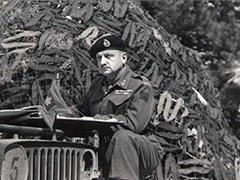 Burns was born in Montreal, Quebec to a Military family. He served with the 17th Duke of York's Royal Canadian Hussars where he was a signal sergeant. After graduating from Royal Military College, he joined the Royal Canadian Engineers as a second lieutenant in 1915.
Burns was born in Montreal, Quebec to a Military family. He served with the 17th Duke of York's Royal Canadian Hussars where he was a signal sergeant. After graduating from Royal Military College, he joined the Royal Canadian Engineers as a second lieutenant in 1915.
During World War 1, he served with the 3rd Canadian Division Signals Company and with the Royal Canadian Engineers from 1916 to 1918. At the end of the war, he was the youngest Captain in the Army. He remained with the military after the war. Between the wars, Burns studied widely. He attended the School for Military Engineering in England, Staff College in India, and the Imperial Defense College in England. He also taught field Engineering at RMC. He was also an advocate of Armoured Vehicles and wrote several articles promoting them for the Canadian Defense Quarterly and the American Mercury.
At various times, Burns commanded the 4th Canadian Armoured Division, the 1st Canadian Infantry Division, the 5th Canadian Armoured Division, and ultimately I Canadian Corps in Italy. In 1940, when Maj-Gen Crerar returned to Canada to head up the Canadian Military as Chief of General Staff; he brought Burns with him as his assistant deputy.
After the war, Burns joined the Department of External Affairs and was seconded to the UN. He commanded the UN Emergency Force in the Middle east from 1954 to 1959. He then became an advisor to the Canadian Government on strategic disarmament. He finished his career as a professor at Carleton University and wrote several books including Manpower and the Canadian Army, 1939-1945 (1956), General Mud: Memoirs of Two World Wars (1970), Between Arab and Israeli (1962), Megamurder (1966) and A Seat at the Peace Table: The Struggle for Disarmament (1972).

General Charles Foulkes, CC, CB, CBE, DSO, CD (3 January 1903 – 12 September 1969)
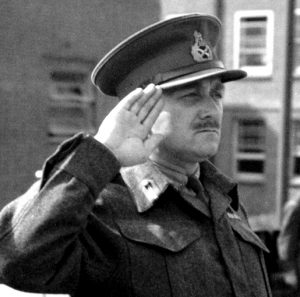 Charles Foulkes was born in Stockton-on-Tees, England, and came to Canada when he was young. He was educated at the University of Western Ontario.
Charles Foulkes was born in Stockton-on-Tees, England, and came to Canada when he was young. He was educated at the University of Western Ontario.
Foukles commissioned as a lieutenant in The Royal Canadian Regiment in 1926. After attending British Staff College, he became a Captain in 1939.
At the start of the war, he was a Major with 3rd Canadian Infantry Brigade and was promoted brigadier in September 1942 to command the Brigade. In April 1943, he became Brigadier General Staff, First Canadian Army. He was promoted major-general in January 1944 and commanded the 2nd Canadian Infantry Division in the U.K. and in North-West Europe until November 1944, when he was promoted lieutnant-general and assumed command of the 1st Canadian Corps in Italy. This corps moved to North-West Europe in February 1945 and, as part of the First Canadian Army, completed the liberation of Holland.
After the war, he stayed in the military and was appointed Chief of the General Staff in 1945. In 1951, he was appointed Chairman, Chiefs of Staff, and was the Canadian Military Representative to the North Atlantic Treaty Organization. He was promoted to the rank of general on 26 January 1954. After his retirement in 1960, he was a visiting lecturer at Carlton University.
II Canadian Corps was authorized on 14 January 1943. It was composed of Canadian Forces not in I Canadian Corps which were later engaged in Europe. These units were 2CID, 3CID, 4CAD, and 2CAB.
II Canadian Corps engaged in combat in Northwest Europe from D-Day to VE Day. The Corps was the tip of the spear from Caen to Falaise, closing the Falaise Gap in 21 Aug 1944. The were then the left flank of the advancing Allied armies, moving up the coast and taking many port towns. The Corps also was heavily involved in liberating Belgium and the Netherlands. Starting with the Battle of the Scheldt and then the eastern provinces of the Netherlands before driving to the Rhine. Following that, the Corps liberated the northern part of the Netherlands and then crossed into Germany’s North Sea coast.
The Corps was active in Europe with attached units from Poland and Britain for certain operations.
Commanders

Ernest William Sansom, CB DSO (December 18, 1890 – October 18, 1982)
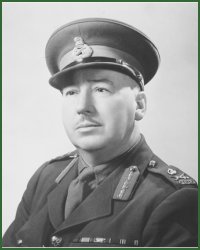 Sansom was born in Stanley, New Brunswick. He joined the 71st York Regiment in 1905 and commissioned in 1907.
Sansom was born in Stanley, New Brunswick. He joined the 71st York Regiment in 1905 and commissioned in 1907.
In World War I, he served in the 12th Infantry Battalion and later with the Canadian Machine Gun Corps of the Canadian - commanding its 1st Battalion.
After the war, he stayed in the Military eventually reaching the rank of Colonel and serving as the Director of Military Training.
Early in World War 2, he was posted as the Assistant Adjutant and Quartermaster General for the 1st Canadian Infantry Division in England. He was promoted to Major-General in 1940 and commanded the 3rd Canadian Infantry Division. He took command of the 5th Armoured Division in 1941. promotion to Lieutenant-General and Commander-in-Chief of II Canadian Corps became effective on January 15, 1943.
He returned to Canada for medical reasons in January 2955. In 1945, he became the Inspector General, Canadian Army Overseas. He retired in 1945. After retirement, he worked with many fund-raising and charity organizations.

Lieutenant-General Guy Granville Simonds, CC, CB, CBE, DSO, CD (April 23, 1903 – May 15, 1974)
 Guy Simonds was born in Ixworth, near Bury St Edmunds, Suffolk, England to a military family. His family emmigrated to British Columbia in 1911. His father enlisted for World War 1 and was wounded in 1918; released with the rank of Colonel. The war was hard on the family and Simonds has to leave school to work,
Guy Simonds was born in Ixworth, near Bury St Edmunds, Suffolk, England to a military family. His family emmigrated to British Columbia in 1911. His father enlisted for World War 1 and was wounded in 1918; released with the rank of Colonel. The war was hard on the family and Simonds has to leave school to work,
He attended the Royal Military College of Canada in Kingston, Ontario and at graduation he was awarded the Sword of Honour for t0p candidate in 1925.
He commissioned in 1926 into the Royal Canadian Horse Artillery. He attended the Gunnery Staff Course (1932) and then Staff College (1936) in England. Newly a Major, he instructed at the Royal Military College of Canada in Artillery and Tactics.
At the start of World War 2, he was a staff officer with the 1st Canadian Infantry Division but left to command the 1st Field Regiment, Royal Canadian Artillery. After a stint as the commandant of the Canadian Junior War Staff Course in November 1940, he joined 2nd Canadian Infantry Division as a staff officer. In August 1941, he was made acting Brigadier General Staff of I Canadian Corps until mid-July 1942.
In September 1942, he was made commander of the 1st Infantry Brigade in 1st Canadian Infantry Division.
In April 1943, Simonds was promoted to major-general and commander of 2nd Canadian Infantry Division, This position was short lived as nine days later, he was transferred to command the 1st Canadian Infantry Division, replacing Major-General Harry Salmon who had died in a plane accident. He led the 1st Canadian Division through Sicily and then Italy. At 40, he was the youngest Canadian officer to lead a division in action.
In September 1843, Brigadier Christopher Vokes replaced Simonds as commander of the 1st Canadian Division due to illness. Upon recovery, he took command of the 5th Canadian (Armoured) Division in November 1943.
In January 1944 he was recalled to the United Kingdom to take command of II Canadian Corps. It was claimed at the time that Simonds was the youngest corps commander in the British Empire. As part of his taking over, many older officers such as F. F. Worthington (commander of 4th Canadian Armoured Division) were removed.
Once II Corps was activated, Simonds would direct four major attacks during the Battle of Normandy. In September 1944, Simonds temporarily took charge of the First Canadian Army from Lieutenant-General Harry Crerar, who was recovering from a bout of dysentery, and led the liberation of the mouth of the Scheldt River. When Crerar resumed command with the First Army, Simonds resumed his command of II Canadian Corps for the liberation of North-Western Europe.
After the war ended, he was Chief Instructor at the Imperial Defence College(1946–1949). After that, he took charge of of both the Canadian Army Staff College and the National Defence College. He was became the Chief of the General Staff in 1951 and retired in 1955.
After his retirement, Simonds was President of United Ceramics, Frontenac Floor and Tile, and the Toronto Brick Company. He was also Vice-President and a Director of Commercial Life and Halifax Insurance. He worked with The Royal Life Saving Society of Canada, the Gurkha Appeal, the Canadian Corps of Commissionaires and was chairman of the National Ballet of Canada.
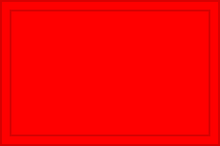
1st Canadian Division Headquarters
1st Canadian Infantry Brigade
2nd Canadian Infantry Brigade
3rd Canadian Infantry Brigade

1st Canadian Infantry Division (1CID) was mobilized in September 1939. 1CID sailed for England in two groups – 10 December 1939 and 22 December 1939.
Elements of 1CID (1st CIB) were dispatched to France in June 1940 but withdrawn shortly after the fall of Paris without any contact with the German forces.
1CID spent the next two years in England at first in defensive positions due to the threat of invasion, then in training both for the defense of England but also for invasion.
1CID landed in Sicily as a part of Operation Husky (9 July 1943) and then worked its way up the Italian countryside. 1CID crossed into Italy on 3 September 1943.
In 1945, 1CID moved to North-West Europe to join 1st Canadian Army. 1CID was committed to the liberation of the lowlands and ended the war near Rotterdam.
Commanders

General Andrew George Latta McNaughton CH CB CMG DSO CD PC (25 February 1887 – 11 July 1966)
 McNaughton was born in Moosomin, Saskatchewan but moved to Quebec later in live to attend Bishop's College School and then McGill University. He received degrees in Physics, Engineering, and Electrical Engineering before becoming a Professor of Engineering.
McNaughton was born in Moosomin, Saskatchewan but moved to Quebec later in live to attend Bishop's College School and then McGill University. He received degrees in Physics, Engineering, and Electrical Engineering before becoming a Professor of Engineering.
He joined the Militia in 1909 and by 1914 commanded the 3rd Field Battery in Montreal.
He served throughout the First World War. He was wounded twice and mentioned in dispatches three times. By the end of the war (at the age of 31), he was promoted to Brigadier General and commanded all Canadian Artillery.
He was known as a scientific gunner and introduced detection techniques such as sound and flash ranging. He invented a technique for the measurement of barrel wear and integrating that into aiming. He also introduced techniques for precision targeting and the creeping barrage.
After the war, McNaughton joined the permanent forces. He was a member of the Otter Commission and was instrumental in moving the PPCLI and the Royal 22nd Regiment to the permanent forces. He did not stop his science interests and developed the Cathode Ray Direction Finder (a fore-runner of RADAR) and employed it for aerial mapping of Canada's north.
McNaughton left the military and headed the National Research Council of Canada from 1935 to 1939.
At the start of World War 2, McNaughton rejoined the Military and commanded 1st Canadian Infantry Division. In July 1940, British VII Corps was created to defend England from the threat of German Invasion. In December 1940, 1st and 2nd Canadian Infantry Corps join together to become the Canadian Corps. McNaughton commands this until November 1941. With the influx of Canadian forces into England, Canadian Corps became I Canadian Corps and a new II Canadian Corps was created - the two became the 1st Canadian Army commanded by McNaughton.
McNaughton was adamant that the 1st Canadian Army should fight as a single unit and not be broken up. This caused many issues and in December 1943, McNaughton is removed from command and returns to Canada.
After a short stint as the Minister of National Defense (1944 - 1945), McNaughton chaired the United Nations Atomic Energy Commission from 1946 to 1948; served as Canada's Ambassador to the United Nations from 1948 to 1949; and chaired the Canadian Section of the International Joint Commission from 1950 to 1962.

Major General George Pearkes, VC, PC, CC, CB, DSO, MC, CD, OD (February 28, 1888 – May 30, 1984)
 Pearkes was born in Watford, Hertfordshire, England. In 1906, he and his brother came to Canada, and lived near Red Deer. In 1911, he joined the North-West Mounted Police in the Yukon.
Pearkes was born in Watford, Hertfordshire, England. In 1906, he and his brother came to Canada, and lived near Red Deer. In 1911, he joined the North-West Mounted Police in the Yukon.
In 1915, he joins the 2nd Canadian Mounted Rifles and then the 5th Canadian Mounted Rifles in 1918. During the war, he was wounded at least 4 times.
At the Battle of Passchendaele, Pearkes was a 29 year old Acting Major when his actions (while wounded) during an attack saw him awarded the Victoria Cross. By the end of the war, he had been promoted to lieutenant colonel and had been awarded the DSO and MC as well.
Between the wars, Pearkes stayed in the permanent forces as a member of the PPCLI in western Canada - commanding the 13th Military District (Calgary) from 1938 to 1940.
In 1940, Pearkes took command of the 2nd Canadian Infantry Brigade and went to England as part of 1st Canadian Infantry Brigade.
In November 1941, Pearkes took temporary command of the Canadian Corps when McNaughton returned to Canada due to ill health. He commanded the Corps until Gen Harry Crerar assumed Corps command in April 1942. In August 1942, he returned to Canada to head up Pacific Command. He retired from the Army in February 1945 when he was not granted a change of command.
From 1945 to 1960, he was active in Federal politics eventually serving as Minister of National Defense to PM John Diefenbaker. Notably, it was his recommendation to cancel the AVRO Arrow program.
He also served as Lt-Governor of British Columbia from 1960 to 1968.

Major General Harry Leonard Nowell Salmon MC & Bar (February 9, 1894 – April 29, 1943)
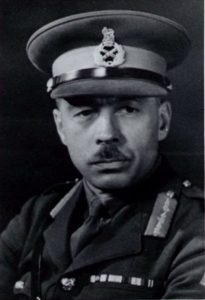 Harry Salmon was born in Winnipeg, Manitoba, Canada. After attending St. John's College in Winnipeg, he worked as a clerk.
Harry Salmon was born in Winnipeg, Manitoba, Canada. After attending St. John's College in Winnipeg, he worked as a clerk.
He enlisted in 1914 with the 95th Saskatchewan Rifles out of Regina, but served with the 28th Battalion, overseas. He was awarded the Military Cross in October 1916 after which he was seriously wounded. He was later awarded the Bar to his Military Cross for actions at Ypres in November 1917.
Between the wars, he served with the Royal Canadian Regiment as well as in staff duties and found time to attend the Imperial Defense College in the United Kingdom.
He joined the 1st Canadian Infantry Division in January 1940 After being promoted to Lt. Col. in February 1940, he took command of the the Hastings and Prince Edward Regiment. Following Dunkirk, Salmon led his regiment in France until the fall of Paris. By September 1942, Salmon was commanding the 7th Canadian Infantry Brigade (Royal Winnipeg Rifles, Regina Rifle Regiment, Canadian Scottish Regiment) and was then tasked to command 1st Canadian Division.
In April 1943, Salmon was killed in an aircraft crash near Chivenor, England. He was on his way to a planning session for Operation Husky in Cairo - He was the head of the Canadian Contingent. Lt-Gen Simonds then took over the Division.

Lieutenant-General Guy Granville Simonds, CC, CB, CBE, DSO, CD (April 23, 1903 – May 15, 1974)
 Guy Simonds was born in Ixworth, near Bury St Edmunds, Suffolk, England to a military family. His family emmigrated to British Columbia in 1911. His father enlisted for World War 1 and was wounded in 1918; released with the rank of Colonel. The war was hard on the family and Simonds has to leave school to work,
Guy Simonds was born in Ixworth, near Bury St Edmunds, Suffolk, England to a military family. His family emmigrated to British Columbia in 1911. His father enlisted for World War 1 and was wounded in 1918; released with the rank of Colonel. The war was hard on the family and Simonds has to leave school to work,
He attended the Royal Military College of Canada in Kingston, Ontario and at graduation he was awarded the Sword of Honour for t0p candidate in 1925.
He commissioned in 1926 into the Royal Canadian Horse Artillery. He attended the Gunnery Staff Course (1932) and then Staff College (1936) in England. Newly a Major, he instructed at the Royal Military College of Canada in Artillery and Tactics.
At the start of World War 2, he was a staff officer with the 1st Canadian Infantry Division but left to command the 1st Field Regiment, Royal Canadian Artillery. After a stint as the commandant of the Canadian Junior War Staff Course in November 1940, he joined 2nd Canadian Infantry Division as a staff officer. In August 1941, he was made acting Brigadier General Staff of I Canadian Corps until mid-July 1942.
In September 1942, he was made commander of the 1st Infantry Brigade in 1st Canadian Infantry Division.
In April 1943, Simonds was promoted to major-general and commander of 2nd Canadian Infantry Division, This position was short lived as nine days later, he was transferred to command the 1st Canadian Infantry Division, replacing Major-General Harry Salmon who had died in a plane accident. He led the 1st Canadian Division through Sicily and then Italy. At 40, he was the youngest Canadian officer to lead a division in action.
In September 1843, Brigadier Christopher Vokes replaced Simonds as commander of the 1st Canadian Division due to illness. Upon recovery, he took command of the 5th Canadian (Armoured) Division in November 1943.
In January 1944 he was recalled to the United Kingdom to take command of II Canadian Corps. It was claimed at the time that Simonds was the youngest corps commander in the British Empire. As part of his taking over, many older officers such as F. F. Worthington (commander of 4th Canadian Armoured Division) were removed.
Once II Corps was activated, Simonds would direct four major attacks during the Battle of Normandy. In September 1944, Simonds temporarily took charge of the First Canadian Army from Lieutenant-General Harry Crerar, who was recovering from a bout of dysentery, and led the liberation of the mouth of the Scheldt River. When Crerar resumed command with the First Army, Simonds resumed his command of II Canadian Corps for the liberation of North-Western Europe.
After the war ended, he was Chief Instructor at the Imperial Defence College(1946–1949). After that, he took charge of of both the Canadian Army Staff College and the National Defence College. He was became the Chief of the General Staff in 1951 and retired in 1955.
After his retirement, Simonds was President of United Ceramics, Frontenac Floor and Tile, and the Toronto Brick Company. He was also Vice-President and a Director of Commercial Life and Halifax Insurance. He worked with The Royal Life Saving Society of Canada, the Gurkha Appeal, the Canadian Corps of Commissionaires and was chairman of the National Ballet of Canada.

Major General Christopher Vokes CB, CBE, DSO, CD (13 April 1904 – 27 March 1985)
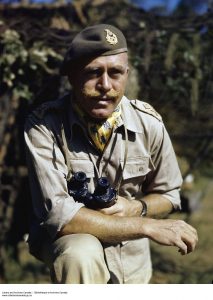 Vokes was born in the town of Armagh, Ireland to a British officer, Major Frederick Patrick Vokes. By 1919, Vokes' father was the engineering officer at the Royal Military College in Kingston, Ontario.
Vokes was born in the town of Armagh, Ireland to a British officer, Major Frederick Patrick Vokes. By 1919, Vokes' father was the engineering officer at the Royal Military College in Kingston, Ontario.
His brother, Lieutenant-Colonel Frederick Vokes,was at Dieppe and commanded the British Columbia Dragoons in Italy. He was wounded in action and died September 1944.
Vokes attended the Royal Military College of Canada from 1921 to 1925. After graduation, he commissioned into the Royal Canadian Engineers. He then attended McGill University from 1926 to 1927. He later attended Staff College, Camberley in England (1936).
When the war started, Vokes was a Staff Officer for the !1st Canadian Infantry Division, In this capacity, he served as Adjutant General, Assistant Quartermaster General, and General Staff Officer. He then commanded the PPCLI. By June 1942, he was promoted Brigadier and commanded the 2nd Canadian Infantry Brigade through Sicily.
Again promoted to Maj-Gen, he commanded 1st Canadian Infantry Division through Italy including the Battle of Ortona.
In December 1944, he took command of the 4th Canadian Armoured Division for the attack into Germany (Battle of the Hochwald).
From the end of the war to May 1946, Vokes commanded the Canadian Army Occupation Force in Europe. Returning to Canada, he commanded Central Command and then Western Command.
He retired 1959 and in 1985 published his memoirs, My Story.

Major General Harry Wickwire Foster CBE, DSO (April 2, 1902 – August 6, 1964)
Foster was born in Halifax, NS and was born to a Military family. His father Maj-Gen Gilbert Foster was the Director General and commanded all medical staff in Europe during WW1 and was Canada's 6th Surgeon General.
Foster failed his third year at RMC but took a commission with Lord Strathcona's Horse in 1924, making Captain in 1934.
At the beginning of World War 2, he was the Brigade Major for 1st Canadian Infantry Brigade. He then commanded 4th Reconnaissance Battalion (4th Princess Louise Dragoon Guards) having been promoted to Lt-Col. In 1942, he took command of the 1st Battalion, The Highland Light Infantry of Canada.
1943 saw him on the other side of the world where he commanded the 13th Canadian Infantry Brigade (2nd Battalion, The Canadian Scottish, The Brockville Rifles, and 1st Battalion, The Edmonton Fusiliers) at Kiska Alaska (Operation Cottage). Later that year, he was promoted Brigadier and led the 7th Canadian Infantry Brigade on Juno Beach, D-Day.
 In 1944, he was promoted to major general commanding 4th Canadian (Armoured) Division in Normandy.
In 1944, he was promoted to major general commanding 4th Canadian (Armoured) Division in Normandy.
Later, Foster and Maj-Gen Vokes traded comands due to Vokes poor relationship with Maj-Gen Charles Folkes in I Canadian Corps. Foster the 1st Canadian Infantry Division in Italy, then returned with this division to North-West Europe as part of Operation Goldflake for the remainder of the war.
After the war, Foster presided over the courts martial of SS General Kurt Meyer for war crimes involving the killing of Canadian Prisoners of War. Foster commanded the Eastern Army command until his retirement in 1952 when he took over the administration of the Central European District for the Imperial War Graves Commission.

2nd Canadian Division Headquarters
4th Canadian Infantry Brigade
5th Canadian Infantry Brigade
6th Canadian Infantry Brigade

2nd Canadian Infantry Division (2CID) was mobilized in September 1939 at the same time as 1CID. However, there was a temporary halt to recruitment due to a lack of supplies. Organization was not complete until after June 1940. Even after June 1940, the Division was spread out across Canada with 4th CIB in Borden, 5th CIB in Valcartier, and 6th in Shilo.
The majority of 2CID moved to England in August 1940. There was a brief relocation of two units (Royal Regiment, Mount Royal Fusiliers) to Iceland for a short Garrison stay until the end of October of that year; at which point they rejoined the rest of the formation.
2CID supplied the bulk of the Canadian Forces for Operation Jubilee (Dieppe) on 19 August 1942. Of the 5,000 Canadian Soldiers committed to the Dieppe landing, over half were causalities (Killed, Wounded, or Captured), In all, only 6% of those who landed on the beaches, were able to return to England.
On D-Day, 2CID did not land but was held in Reserve.
In the summer of 1944, 2CID was active in Normandy. by August, the unit had moved into the valley of the Seine. In September, 2CID was tasked with securing Channel ports. The first was Dieppe, which they captured on 3 September. The next day, the British captured Antwerp. 2CID then focused on the Scheldt Estuary which had to be secured before Antwerp was a viable port. It took 2CID over a month to to take the Scheldt during which they lost over 3,600 soldiers.
March saw 2CID in the Hotchwald Gap to assist in taking the Rhine Crossing. The end of the war saw them in Oldenburg on the German North Coast.
Commanders

Victor Wentworth Odlum, CB, CMG, DSO (21 October 1880 – 4 April 1971)
 Odlum was born in Cobourg, Ontario. At the age of 6 his family moved to Japan and then to BC when he was 10 (1889).
Odlum was born in Cobourg, Ontario. At the age of 6 his family moved to Japan and then to BC when he was 10 (1889).
At age 19, Odlum fought in the South African War with The Royal Canadian Regiment. After the war, he became a journalist and was the editor of the Vancouver World newspaper at the age of 25 (1905).
World War 1 saw Odlum as a Major (2IC) in the 7th Battalion (1st British Columbia). At Ypres, he was gassed and later, took command when his commanding officer was killed. He was calm and collected under fire and was promoted regularly by General Currie. By the end of the war, he had been wounded three times and had achieved the rank of Brigadier General.
After the war, he returned to Vancouver where he owned the Vancouver Daily Star (until he shut it down to stop his employees from unionizing) and served in the Provincial Legislature. He also served on the Board of Governors of the CBC from its inception in 1936 until the start of the war.
At the start of the war, Odlum used his political connections to secure the rank of Major General and the command of the 2nd Canadian Infantry Division.
Odlum was not capable of commanding a modern military unit but because of his political connections could not be removed so he was made High Commissioner to Australia to remove him from his post.

John Hamilton "Ham" Roberts CB DSO MC (December 21, 1891 – December 17, 1962)
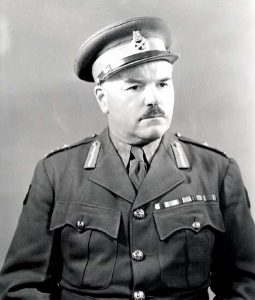 Roberts was born in Pipestone, Manitoba. He studied in Upper Canada College and then Royal Military College of Canada in Kingston, Ontario in 1914.
Roberts was born in Pipestone, Manitoba. He studied in Upper Canada College and then Royal Military College of Canada in Kingston, Ontario in 1914.
He accepted a commission in the Royal Canadian Artillery during the First World War. In 1915 he arrived in Flanders and in 1916, while fighting at the Somme he won the Military Cross for gallantry. In 1918 he was wounded and removed to England to recover and served out the war as an artillery instructor.
Between the wars, he continued to serve as an artillery instructor.
From 1939, he commanded the 1st Regiment, Royal Canadian Horse Artillery in Northern France. At the time of the evacuation in May 1940, he was noted as being the only officer evacuate with all of his guns. He was later promoted to Major General and commander of the 2nd Canadian Infantry Division in 1941.
in August 1942 as a part of Operation Jubilee (Diepe), Roberts in charge of the ground elements for the raid. With poor communications, he had little awareness of the situation and was later severely criticized. However, it was his poor performance during a war-game (Operation Spartan) in March 1943 rather than the Dieppe raid, which ended Roberts's career as hewas judged unfit to hold a combat command.
He held no further operational commands. After the war, he was part of the Commonwealth War Graves Commission.

General Henry Duncan Graham "Harry" Crerar CH, CB, DSO, CD, PC (April 28, 1888 – April 1, 1965)
 Crerar was born in Hamilton, Ontario and attended Upper Canada College and Royal Military College of Canada.
Crerar was born in Hamilton, Ontario and attended Upper Canada College and Royal Military College of Canada.
Crear joined the artillery in 1910 and rose to the rank of lieutenant-colonel of artillery in World War I. After the war, he stayed in the military.
He held a number of staff positions during the interwar years, including Commandant of the Royal Military College of Canada in 1939.
At the beginning of World War 2, Crerar held primarily staff position until the end of 1940 when he was Chief of the General Staff. He commanded 2nd Canadian Infantry Division from 1941 until April of 1942 when he took command of I Canadian Corps. In November of 1942, he commanded I Canadian Corps in Italy.
In March 1944, he rose to command 1st Canadian Army which also included both British and Polish units including the Polish 1st Armoured Division.
In early 1944, the 3rd Canadian Infantry Division and 2nd Canadian Armoured Brigade participate in the assault phase of the Normandy landings aspart of British I Corps. II Canadian Corps became complete in July 1944 when the 2nd Canadian Infantry Division landed.
1st Canadian Army HQ was established in Europe in July 1944. With I Canadian Corp in Italy, 1st Canadian Army did not become complete until the April 1945 when I Canadian Corps moved from Italy to Europe as part of Operation Goldflake.
He was made a full General in November 1944. Crerar returned to Canada in 1945 and retired in 1946.
After the war, he became a diplomat and represented Canada in Czechoslovakia, Japan, and the Netherlands.

Lieutenant-General Guy Granville Simonds, CC, CB, CBE, DSO, CD (April 23, 1903 – May 15, 1974)
 Guy Simonds was born in Ixworth, near Bury St Edmunds, Suffolk, England to a military family. His family emmigrated to British Columbia in 1911. His father enlisted for World War 1 and was wounded in 1918; released with the rank of Colonel. The war was hard on the family and Simonds has to leave school to work,
Guy Simonds was born in Ixworth, near Bury St Edmunds, Suffolk, England to a military family. His family emmigrated to British Columbia in 1911. His father enlisted for World War 1 and was wounded in 1918; released with the rank of Colonel. The war was hard on the family and Simonds has to leave school to work,
He attended the Royal Military College of Canada in Kingston, Ontario and at graduation he was awarded the Sword of Honour for t0p candidate in 1925.
He commissioned in 1926 into the Royal Canadian Horse Artillery. He attended the Gunnery Staff Course (1932) and then Staff College (1936) in England. Newly a Major, he instructed at the Royal Military College of Canada in Artillery and Tactics.
At the start of World War 2, he was a staff officer with the 1st Canadian Infantry Division but left to command the 1st Field Regiment, Royal Canadian Artillery. After a stint as the commandant of the Canadian Junior War Staff Course in November 1940, he joined 2nd Canadian Infantry Division as a staff officer. In August 1941, he was made acting Brigadier General Staff of I Canadian Corps until mid-July 1942.
In September 1942, he was made commander of the 1st Infantry Brigade in 1st Canadian Infantry Division.
In April 1943, Simonds was promoted to major-general and commander of 2nd Canadian Infantry Division, This position was short lived as nine days later, he was transferred to command the 1st Canadian Infantry Division, replacing Major-General Harry Salmon who had died in a plane accident. He led the 1st Canadian Division through Sicily and then Italy. At 40, he was the youngest Canadian officer to lead a division in action.
In September 1843, Brigadier Christopher Vokes replaced Simonds as commander of the 1st Canadian Division due to illness. Upon recovery, he took command of the 5th Canadian (Armoured) Division in November 1943.
In January 1944 he was recalled to the United Kingdom to take command of II Canadian Corps. It was claimed at the time that Simonds was the youngest corps commander in the British Empire. As part of his taking over, many older officers such as F. F. Worthington (commander of 4th Canadian Armoured Division) were removed.
Once II Corps was activated, Simonds would direct four major attacks during the Battle of Normandy. In September 1944, Simonds temporarily took charge of the First Canadian Army from Lieutenant-General Harry Crerar, who was recovering from a bout of dysentery, and led the liberation of the mouth of the Scheldt River. When Crerar resumed command with the First Army, Simonds resumed his command of II Canadian Corps for the liberation of North-Western Europe.
After the war ended, he was Chief Instructor at the Imperial Defence College(1946–1949). After that, he took charge of of both the Canadian Army Staff College and the National Defence College. He was became the Chief of the General Staff in 1951 and retired in 1955.
After his retirement, Simonds was President of United Ceramics, Frontenac Floor and Tile, and the Toronto Brick Company. He was also Vice-President and a Director of Commercial Life and Halifax Insurance. He worked with The Royal Life Saving Society of Canada, the Gurkha Appeal, the Canadian Corps of Commissionaires and was chairman of the National Ballet of Canada.

Lieutenant General Eedson Louis Millard "Tommy" Burns, CC, DSO, OBE, MC, CD (June 17, 1897 – September 13, 1985)
 Burns was born in Montreal, Quebec to a Military family. He served with the 17th Duke of York's Royal Canadian Hussars where he was a signal sergeant. After graduating from Royal Military College, he joined the Royal Canadian Engineers as a second lieutenant in 1915.
Burns was born in Montreal, Quebec to a Military family. He served with the 17th Duke of York's Royal Canadian Hussars where he was a signal sergeant. After graduating from Royal Military College, he joined the Royal Canadian Engineers as a second lieutenant in 1915.
During World War 1, he served with the 3rd Canadian Division Signals Company and with the Royal Canadian Engineers from 1916 to 1918. At the end of the war, he was the youngest Captain in the Army. He remained with the military after the war. Between the wars, Burns studied widely. He attended the School for Military Engineering in England, Staff College in India, and the Imperial Defense College in England. He also taught field Engineering at RMC. He was also an advocate of Armoured Vehicles and wrote several articles promoting them for the Canadian Defense Quarterly and the American Mercury.
At various times, Burns commanded the 4th Canadian Armoured Division, the 1st Canadian Infantry Division, the 5th Canadian Armoured Division, and ultimately I Canadian Corps in Italy. In 1940, when Maj-Gen Crerar returned to Canada to head up the Canadian Military as Chief of General Staff; he brought Burns with him as his assistant deputy.
After the war, Burns joined the Department of External Affairs and was seconded to the UN. He commanded the UN Emergency Force in the Middle east from 1954 to 1959. He then became an advisor to the Canadian Government on strategic disarmament. He finished his career as a professor at Carleton University and wrote several books including Manpower and the Canadian Army, 1939-1945 (1956), General Mud: Memoirs of Two World Wars (1970), Between Arab and Israeli (1962), Megamurder (1966) and A Seat at the Peace Table: The Struggle for Disarmament (1972).

General Charles Foulkes, CC, CB, CBE, DSO, CD (3 January 1903 – 12 September 1969)
 Charles Foulkes was born in Stockton-on-Tees, England, and came to Canada when he was young. He was educated at the University of Western Ontario.
Charles Foulkes was born in Stockton-on-Tees, England, and came to Canada when he was young. He was educated at the University of Western Ontario.
Foukles commissioned as a lieutenant in The Royal Canadian Regiment in 1926. After attending British Staff College, he became a Captain in 1939.
At the start of the war, he was a Major with 3rd Canadian Infantry Brigade and was promoted brigadier in September 1942 to command the Brigade. In April 1943, he became Brigadier General Staff, First Canadian Army. He was promoted major-general in January 1944 and commanded the 2nd Canadian Infantry Division in the U.K. and in North-West Europe until November 1944, when he was promoted lieutnant-general and assumed command of the 1st Canadian Corps in Italy. This corps moved to North-West Europe in February 1945 and, as part of the First Canadian Army, completed the liberation of Holland.
After the war, he stayed in the military and was appointed Chief of the General Staff in 1945. In 1951, he was appointed Chairman, Chiefs of Staff, and was the Canadian Military Representative to the North Atlantic Treaty Organization. He was promoted to the rank of general on 26 January 1954. After his retirement in 1960, he was a visiting lecturer at Carlton University.

Major General Albert Bruce Matthews, CBE DSO ED (August 12, 1909 – September 12, 1991)
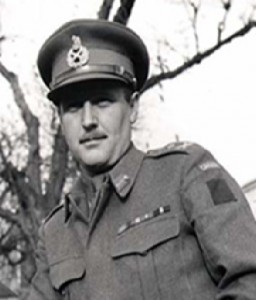 Matthews was born 1909 in Ottawa, Ontario to a well off family. His father was a successful stock broker and had political connections leading to his appointment as Lieutenant-Governor of Ontario in 1937.
Matthews was born 1909 in Ottawa, Ontario to a well off family. His father was a successful stock broker and had political connections leading to his appointment as Lieutenant-Governor of Ontario in 1937.
Bruce Matthews was educated at Upper Canada College in Toronto, and at Geneva University before joining his father.. He then joined the family firm.
Matthews, was by both the Royal Military College of Canada and the Royal Canadian Navy Reserve due to colour blindness. But in 1928, Nevertheless, in 1928; he joined the Royal Canadian Artillery as a provisional lieutenant made captain within five years. By 1938, he commanded the 15th Field Battery,
Matthews was promoted rapidly during the war. At the beginning, he was posted into the 1st Canadian Infantry Division and by March 1939 - he was commanding a battery. As a Lt-Col, . he built the 5th Medium Regiment in September 1941. He became the youngest Brigadier in the Canadian army when he became Commander of the Royal Artillery for the 1st Canadian Infantry Division in January 1943.
Matthews served in Sicily and Italy until being transferred back to England with II Canadian Corps as their commander of Corps Artillery. He was active in Normandy in July 1944 where he proved a master at large scale artillery support.
In November 1944, Matthews was promoted to major general and commander of 2nd Canadian Infantry Division until the end of the war; directing it through the Rhineland, the Hochwald and the Northern Netherlands.
After the war, Matthews left the Military and became a very successful business man. He also served as the President of the Liberal Party of Canada.

2nd Canadian Division Headquarters
7th Canadian Infantry Brigade
8th Canadian Infantry Brigade
9th Canadian Infantry Brigade
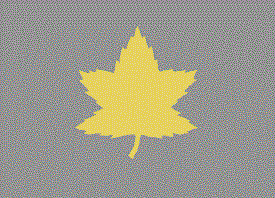
3rd Canadian Infantry Division (3CID) was mobilized in 23 May 1940 in response to the German invasion of the Lowlands. It took until September of that year for the organization to be stabilized and a commanding officer appointed. Elements of 3CID landed in Engjand at the end of July 1941.
In July 1943, it was determined that 3CID would begin training for a role in Operation Overlord. To support this, 3CID became part of 1st British Corps (2nd Army) in 1944 and went into accelerated training.
On D-Day (6 June 1944), 3CID landed in Normandy and spent the next month fighting in and around Caen. In early July/August, they were joined by 2CIB and became 2nd Canadian Corps (1st Canadian Army).
During fighting in Normandy, 156 3CID (North Nova Scotia Highlanders, Royal Winnipeg Rifles) and 27th Canadian Armoured Regiment (Sherbrooke Fusilier Regiment) were executed by 12th SS under Col Kurt Meyer.
After the Falaise Gap, 3CID moved to clear the Scheldt estuary in order to allow the Allies to use the port at Antwerp. It was here that the 3CID gained the nickname “The Water Rats”.
9CIB was the first unit to cross the Rhine River at Rees.
Commanders

Ernest William Sansom, CB DSO (December 18, 1890 – October 18, 1982)
 Sansom was born in Stanley, New Brunswick. He joined the 71st York Regiment in 1905 and commissioned in 1907.
Sansom was born in Stanley, New Brunswick. He joined the 71st York Regiment in 1905 and commissioned in 1907.
In World War I, he served in the 12th Infantry Battalion and later with the Canadian Machine Gun Corps of the Canadian - commanding its 1st Battalion.
After the war, he stayed in the Military eventually reaching the rank of Colonel and serving as the Director of Military Training.
Early in World War 2, he was posted as the Assistant Adjutant and Quartermaster General for the 1st Canadian Infantry Division in England. He was promoted to Major-General in 1940 and commanded the 3rd Canadian Infantry Division. He took command of the 5th Armoured Division in 1941. promotion to Lieutenant-General and Commander-in-Chief of II Canadian Corps became effective on January 15, 1943.
He returned to Canada for medical reasons in January 2955. In 1945, he became the Inspector General, Canadian Army Overseas. He retired in 1945. After retirement, he worked with many fund-raising and charity organizations.

Major General Charles Basil Price DSO DCM (12 December 1890 – 15 February 1975)
Price joined the Victoria Rifles of Canada in 1905 and became an officer in 1914. For World War 1, he resigned his commission to serve as one of the Royal Montreal Regiment's Company Sergeants Major but rose to Major through promotions.
After the war, he commanded the Royal Montreal Regiment as a Lt-Col until his retirement in 1929.
In World War 2, he was posted as Major General commanding 3rd Infantry Division until leaving that post in September 1942 when he became the Overseas Commissioner of the Canadian Red Cross. He kept that position until the end of the war. As part of that role, he was responsible for the welfare of all allied POWs in Axis hands.
He re-enlisted and was posted to England. As a major-general, he commanded the 3rd Canadian Infantry Division from 14 March 1941 until 7 September 1942, when he became the Overseas Commissioner of the Canadian Red Cross Society. In that post, which he held until the war ended, he strove to ensure that all Allied prisoners of war received equal benefits, including one large Red Cross parcel per month containing the best food available (white-flour biscuits; butter instead of oleomargarine, etc.). In 1944 he joined John Bracken's team as the Progressive Conservative candidate in Saint-Antoine—Westmount,[2] and lost to the Liberal incumbent Douglas Charles Abbott by just 60 votes in the 1945 federal election. Later he retired and moved to Knowlton.

Major General Rodney Frederick Leopold Keller CBE (2 October 1900 – 21 June 1954)
 Keller was born in Tetbury, England and attended the Royal Military College in Kingston at the end of World War 1.
Keller was born in Tetbury, England and attended the Royal Military College in Kingston at the end of World War 1.
After graduating, he joined the PPCLI.
When the war began, Keller went over as a brigade major then took command of the Princess Patricia's Canadian Light Infantry in 1941. He very quickly became the commander of the 1st Canadian Infantry Brigade a few months later. In September 1942, Keller was made a major-general and he served as General Officer Commanding the 3rd Canadian Infantry Division.
Keller commanded the 3rd on Juno beach but found that he did not have the required demeanor in Normandy. He was jumpy and indecisive. His immediate superiors tried to have him removed but Simonds refused - even when Keller tried to resign.
However, on 8 August 1944, his headquarters was accidentally bombed by the US Army 8th Bomber Group. Hundreds of Allied solders were killed or wounded by "friendly fire" including Keller.
Keller was evacuated and never held active military command even though he stayed in the military until his retirement.

Major General Daniel Charles Spry CBE DSO CD (February 4, 1913 – April 2, 1989)
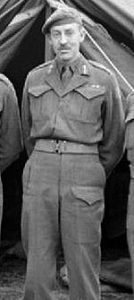 Spry was born in Winnipeg to a military family. His father was a Major-General. He joined the militia (Princess Louise Fusiliers) when he was studying at Dalhousie University.
Spry was born in Winnipeg to a military family. His father was a Major-General. He joined the militia (Princess Louise Fusiliers) when he was studying at Dalhousie University.
In 1933, he joined the Royal Canadian Regiment and was posted to the Royal Military College. At the start of the war, Spry was promoted to Captain with staff duties.
In Sicily, the commander of the Royal Canadian Regiment was killed and Spry took over the regiment. He went on to command 1st Canadian Infantry Brigade and then 12th Canadian Infantry Brigade. In August 1944, he commanded the 3rd Canadian Infantry Division. He commanded the division in Italy and Europe.
He retired from the Army in 1946 and became involved with the Boy Scouts. He was the Chief Commissioner of the Boy Scouts in Canada and then in 195; he moved to Geneva Switzerland to be the Director of the Boy Scouts World Bureau.

Ralph Holley Keefler, CBE DSO ED (September 12, 1902 – September 17, 1983)
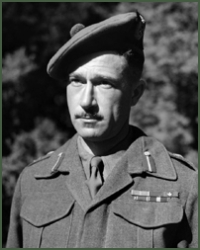 Keefler was born in Weston, Ontario.
Keefler was born in Weston, Ontario.
He graduated from the University of Toronto in 1924 and started working at Bell Telephone Company in Montreal.
Keefler joined the army in 1940 and by 1943, he was in command of the 2nd Division Artillery with rank of Brigadier. He landed on D-Day and was involved in actions through France and in the Low Lands. He commanded 6th Canadian Infantry Brigade in 1945 until he was promoted to Major General and took command of the 3rd Canadian Infantry Division.
After the war, he became president of Northern Electric (Northern Telecom)
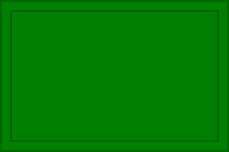
4th Canadian Armoured Headquarters
4th Canadian Armoured Brigade
10th Canadian Infantry Brigade
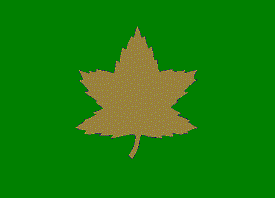
The 4th Canadian Infantry Division was mobilized in 1941 but was re-designated 4th Canadian (Armoured) Division (4CAD) Division in early 1942. This was due to a British request for a second Tank Division (5th Canadian (Armoured) Division was already deployed). Rather than creating a new Division, it was determined to convert an existing infantry division to a tank role. The Government felt that it was less expensive to reallocate an existing (and funded) division than create a new one (requiring new funding to be found).
Unlike 5CAD, 4CAD had access to a larger number of armoured vehicles as was able to arrive in England in the late summer and fall of 1942 with far more training in tank tactics in Canada.
4CAD deployed to Normandy as part of II Canadian Corps on 29 July 1944. During this time, Maj D. V. Currie was awarded the Victoria Cross for actions taken at Saint-Lambert in France. This was the only VC granted to a member of the Canadian Armoured Corps.
4CAD fought throughout the European theatre.
4CAD was commanded by Maj-Gen Worthington from 2 February 1942 until 29 February 1944.
Commanders

Major General Lionel F. Page CB DSO (17December 1884 - 26 August 1944)
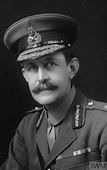 Lionel Frank Page was born in Fordingham, Yorkshire, England and emigrated by himself to Red Deer Albert while in his late teens.
Lionel Frank Page was born in Fordingham, Yorkshire, England and emigrated by himself to Red Deer Albert while in his late teens.
In 1906, he enlisted in the newly formed 15 Light Horse Regiment. Page went into the real estate and brokerage business In 1913, he was commissioned into the 35 Central Alberta Horse.
When World War1 broke out, Page joined the 5th Infantry Battalion. In April 1915, he was gassed. However, he distinguished himself and was quickly promoted major. In March 1917, Page became a lieutenant colonel and the commanding officer of the 50 Battalion. By the end of the war, he had been awarded the DSO and two bars and had been wounded twice.
He moved to Calgary where he was promoted to Lieutenant Colonel and became the L.S.H.’s commanding officer in 1929.
At the beginning of World War 2, , Page was promoted to Brigadier General. He commanded Operation Z when Canadina forces garrisoned Iceland from June 1940 to April 1941. Later that year, he was named the Major General commanding 4th Canadian Armoured Division. In July 1943, he was named the Commander in Chief of the Canadian Army’s Atlantic Command.
Lionel Page died during the war due to the effect of the gas attack that he suffered in WW1.

Major-General Frederic Franklin "Worthy" Worthington, MC, MM, CD (September 17, 1889–December 8, 1967)
For an in-depth biography of Worthington, Click Here.
Worthington was born in Peterhead, Scotland. His family emigrated to California in the early 1900s. When he was 10, his parents died and he moved to Mexico to live with his brother. When his brother was killed, he found work as a cabin boy.
His military career began as a mercenary leading a Gatling Gun team for Nicaragua. When Nicaragua lost, he escaped and went back to sea. Later, he attempted Gun Running to Cuba and in 1913 fought for Madero during the Mexican Civil War - where he was wounded.
World War 1 saw him attempting to get to Scotland to join the Black Watch. Upon arriving in Montreal, he saw a soldier in a kilt and joined up with Royal Highlanders of Canada (Black Watch). He went to World War 1 with the 73rd Battalion (Royal Highlanders of Canada).
Worthington was awarded his Military Medal on 12 March 1917 for actions on 7 January 1917 (Holds off a German raiding party with his machine gun) and the Bar on 9 July 1917 (For actions on 9-11 April 1917 at the Battle of Arras (Battle of the Scarpe)).
Worthington was awarded the Military Cross on 1 February 1919 for actions on 2 September 1918 near Villers France ( conspicuous gallantry leading his battery in open combat) and the Bar on 2 April 1919.
Worthington is wounded in April 1919 and sent to England. While he is recuperating, the 73rd is disbanded. Upon getting out of the hospital, Worthington takes his officer's course and then a machine gun course in order to become a battery commander with 18th Machine Gun Company.
Worthington served in the Canadian Machine Gun Corps in 1917. He was awarded the Military Medal for actions near Vimy Ridge, on 6 January 1917 for holding his position during a German advance.
After the First World War, he stayed in the military first with the Canadian Machine Gun Corps and then with the PPCLI. He was known to be a proponent of armoured fighting vehicles.
After taking courses in England, Worthington is the first commander of the first Armoured Training school in Canada. When the Canadian Armoured Corps was created in 13 August 1949 - he was the first commander.
Worthington organized the 1st Canadian Tank Brigade (later the 1st Canadian Armoured Brigade, an independent formation) and also converted the 4th Canadian Infantry Division to an armoured division in only five months.
In 1944, Worthy was forced to relinquish command of the 4th Armoured Division, "officially" due to poor health,
He returned to Camp Borden, where replacements were trained for the Canadian Armoured Corps and Infantry, as well as the Royal Canadian Army Service Corps and the Canadian Provost Corps.
Worthington served as General Officer Commander in Chief of Pacific Command from 1 April 1945 to 26 January 1946. Later he was appointed the first Colonel-Commandant of the Royal Canadian Armoured Corps and of the Canadian Rangers..

Major-General George Kitching CBE, DSO, CD (1910–1999)
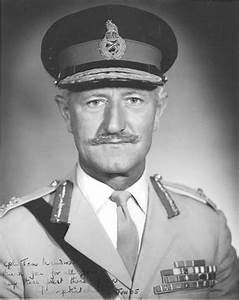 George Kitching was born in Guangzhou (Canton), China.
George Kitching was born in Guangzhou (Canton), China.
Kitching was educated at Sandhurst in the United Kingdom. He then joined the British Army and held several postings in Asia until he resigned from the Army in 1938.
He joined the Canadian Army a year later and attended Staff College in England. He went on to hold staff positions in both 1st Canadian Infantry Division and I Canadian Corps. In 1942 he commanded the Edmonton Regiment for five months before taking a staff position with 1st Canadian Infantry Division in Sicily. For four months after that he commanded 11th Canadian Infantry Brigade and then took command of 4th Canadian Armoured Division in Europe. As a Major General, he was the youngest General in Europe. He commanded the Division through Caen and into Falaise. Lt-Gen Simonds blamed him for not closing the Falaise Gap fast enough and removed him from command. He was demoted to Brigadier but Maj-Gen Foulkes brought him to I Canadian Corps as head of the General Staff where he preformed quite well.
He stayed in the Military and reached the rank of Major-General in 1956. He retired in 1965 and from 1970 to 1984, he headed the Liquor Control Board of Ontario.

Major General Harry Wickwire Foster CBE, DSO (April 2, 1902 – August 6, 1964)
Foster was born in Halifax, NS and was born to a Military family. His father Maj-Gen Gilbert Foster was the Director General and commanded all medical staff in Europe during WW1 and was Canada's 6th Surgeon General.
Foster failed his third year at RMC but took a commission with Lord Strathcona's Horse in 1924, making Captain in 1934.
At the beginning of World War 2, he was the Brigade Major for 1st Canadian Infantry Brigade. He then commanded 4th Reconnaissance Battalion (4th Princess Louise Dragoon Guards) having been promoted to Lt-Col. In 1942, he took command of the 1st Battalion, The Highland Light Infantry of Canada.
1943 saw him on the other side of the world where he commanded the 13th Canadian Infantry Brigade (2nd Battalion, The Canadian Scottish, The Brockville Rifles, and 1st Battalion, The Edmonton Fusiliers) at Kiska Alaska (Operation Cottage). Later that year, he was promoted Brigadier and led the 7th Canadian Infantry Brigade on Juno Beach, D-Day.
 In 1944, he was promoted to major general commanding 4th Canadian (Armoured) Division in Normandy.
In 1944, he was promoted to major general commanding 4th Canadian (Armoured) Division in Normandy.
Later, Foster and Maj-Gen Vokes traded comands due to Vokes poor relationship with Maj-Gen Charles Folkes in I Canadian Corps. Foster the 1st Canadian Infantry Division in Italy, then returned with this division to North-West Europe as part of Operation Goldflake for the remainder of the war.
After the war, Foster presided over the courts martial of SS General Kurt Meyer for war crimes involving the killing of Canadian Prisoners of War. Foster commanded the Eastern Army command until his retirement in 1952 when he took over the administration of the Central European District for the Imperial War Graves Commission.

Major General Christopher Vokes CB, CBE, DSO, CD (13 April 1904 – 27 March 1985)
 Vokes was born in the town of Armagh, Ireland to a British officer, Major Frederick Patrick Vokes. By 1919, Vokes' father was the engineering officer at the Royal Military College in Kingston, Ontario.
Vokes was born in the town of Armagh, Ireland to a British officer, Major Frederick Patrick Vokes. By 1919, Vokes' father was the engineering officer at the Royal Military College in Kingston, Ontario.
His brother, Lieutenant-Colonel Frederick Vokes,was at Dieppe and commanded the British Columbia Dragoons in Italy. He was wounded in action and died September 1944.
Vokes attended the Royal Military College of Canada from 1921 to 1925. After graduation, he commissioned into the Royal Canadian Engineers. He then attended McGill University from 1926 to 1927. He later attended Staff College, Camberley in England (1936).
When the war started, Vokes was a Staff Officer for the !1st Canadian Infantry Division, In this capacity, he served as Adjutant General, Assistant Quartermaster General, and General Staff Officer. He then commanded the PPCLI. By June 1942, he was promoted Brigadier and commanded the 2nd Canadian Infantry Brigade through Sicily.
Again promoted to Maj-Gen, he commanded 1st Canadian Infantry Division through Italy including the Battle of Ortona.
In December 1944, he took command of the 4th Canadian Armoured Division for the attack into Germany (Battle of the Hochwald).
From the end of the war to May 1946, Vokes commanded the Canadian Army Occupation Force in Europe. Returning to Canada, he commanded Central Command and then Western Command.
He retired 1959 and in 1985 published his memoirs, My Story.
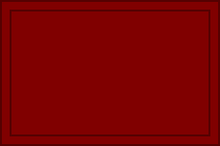
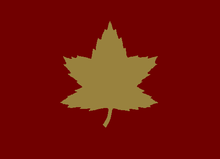
This unit starts life as the 1st Canadian Armoured Division on 27 February 1941. By June, it is renamed 5th Canadian (Armoured) Division to avoid confusion with 1 CID.
5 CAD was set up along British Armoured Division standards with a Headquarters squadron, an Armoured Car regiment for reconnaissance, and two brigades – each with 3 regiments.
5 CAD went overseas to England at the end of 1941; spending two uneventful years training.
In July 1943, 1 CID underwent it first significant transformation into a combined arms unit. One armoured brigade was changed to an infantry unit. (11 Canadian Infantry Brigade).
In November 1943, 5 CAD deployed to Italy to relieve the British 8th Army. Unfortunately, the division took over the 8th’s vehicles and equipment which were in sorry state. It took months to re-equip with new vehicles including new M4 Shermans.
The division participated in the Italian Campaign until the end of 1944. In August 1944, a second infantry brigade (12th Canadian Infantry Brigade) was added to the order of battle. This unit was manned by absorbing other Canadian Infantry Units already in Italy.
After the Italian campaign (January 1945), 5CAD (along with 1CIB) moved to Belgium for North-West Europe campaign. Upon arrival, 12 CIB was disbanded being in existence for only 8 months. The rest of 5 CAD was were able to join 1st Canadian Army in time to move into Germany.
Commanders

Ernest William Sansom, CB DSO (December 18, 1890 – October 18, 1982)
 Sansom was born in Stanley, New Brunswick. He joined the 71st York Regiment in 1905 and commissioned in 1907.
Sansom was born in Stanley, New Brunswick. He joined the 71st York Regiment in 1905 and commissioned in 1907.
In World War I, he served in the 12th Infantry Battalion and later with the Canadian Machine Gun Corps of the Canadian - commanding its 1st Battalion.
After the war, he stayed in the Military eventually reaching the rank of Colonel and serving as the Director of Military Training.
Early in World War 2, he was posted as the Assistant Adjutant and Quartermaster General for the 1st Canadian Infantry Division in England. He was promoted to Major-General in 1940 and commanded the 3rd Canadian Infantry Division. He took command of the 5th Armoured Division in 1941. promotion to Lieutenant-General and Commander-in-Chief of II Canadian Corps became effective on January 15, 1943.
He returned to Canada for medical reasons in January 2955. In 1945, he became the Inspector General, Canadian Army Overseas. He retired in 1945. After retirement, he worked with many fund-raising and charity organizations.

Major General Charles Ramsay Stirling Stein (5 January 1897 - 3 June 1973)
 Charles Ramsey Stirling Stein was born in
Charles Ramsey Stirling Stein was born in
North Vancouver. He was educated both
in Vancouver and in boarding school in
England.
He graduated from the Royal Military College and commissioned into the Royal Canadian Engineers in 1915.
During the First World War, he served in
England and in India; finishing as a Lt-Col..
Between the wars, he was the staff Adjutant at R.M.C.
At the start of the World War 2, he opened an Engineering Training Centre in Halifax, then became Acting Commanding Officer, Military District #7 in St. John, N.B.
In 1940, he became a staffoffice at Canadian Military headquarters in London, England,. After being promoted to Major- General, He was given command of the 5th Canadian Armoured Division in 1943. He retired from the Army in 1944.

Lieutenant-General Guy Granville Simonds, CC, CB, CBE, DSO, CD (April 23, 1903 – May 15, 1974)
 Guy Simonds was born in Ixworth, near Bury St Edmunds, Suffolk, England to a military family. His family emmigrated to British Columbia in 1911. His father enlisted for World War 1 and was wounded in 1918; released with the rank of Colonel. The war was hard on the family and Simonds has to leave school to work,
Guy Simonds was born in Ixworth, near Bury St Edmunds, Suffolk, England to a military family. His family emmigrated to British Columbia in 1911. His father enlisted for World War 1 and was wounded in 1918; released with the rank of Colonel. The war was hard on the family and Simonds has to leave school to work,
He attended the Royal Military College of Canada in Kingston, Ontario and at graduation he was awarded the Sword of Honour for t0p candidate in 1925.
He commissioned in 1926 into the Royal Canadian Horse Artillery. He attended the Gunnery Staff Course (1932) and then Staff College (1936) in England. Newly a Major, he instructed at the Royal Military College of Canada in Artillery and Tactics.
At the start of World War 2, he was a staff officer with the 1st Canadian Infantry Division but left to command the 1st Field Regiment, Royal Canadian Artillery. After a stint as the commandant of the Canadian Junior War Staff Course in November 1940, he joined 2nd Canadian Infantry Division as a staff officer. In August 1941, he was made acting Brigadier General Staff of I Canadian Corps until mid-July 1942.
In September 1942, he was made commander of the 1st Infantry Brigade in 1st Canadian Infantry Division.
In April 1943, Simonds was promoted to major-general and commander of 2nd Canadian Infantry Division, This position was short lived as nine days later, he was transferred to command the 1st Canadian Infantry Division, replacing Major-General Harry Salmon who had died in a plane accident. He led the 1st Canadian Division through Sicily and then Italy. At 40, he was the youngest Canadian officer to lead a division in action.
In September 1843, Brigadier Christopher Vokes replaced Simonds as commander of the 1st Canadian Division due to illness. Upon recovery, he took command of the 5th Canadian (Armoured) Division in November 1943.
In January 1944 he was recalled to the United Kingdom to take command of II Canadian Corps. It was claimed at the time that Simonds was the youngest corps commander in the British Empire. As part of his taking over, many older officers such as F. F. Worthington (commander of 4th Canadian Armoured Division) were removed.
Once II Corps was activated, Simonds would direct four major attacks during the Battle of Normandy. In September 1944, Simonds temporarily took charge of the First Canadian Army from Lieutenant-General Harry Crerar, who was recovering from a bout of dysentery, and led the liberation of the mouth of the Scheldt River. When Crerar resumed command with the First Army, Simonds resumed his command of II Canadian Corps for the liberation of North-Western Europe.
After the war ended, he was Chief Instructor at the Imperial Defence College(1946–1949). After that, he took charge of of both the Canadian Army Staff College and the National Defence College. He was became the Chief of the General Staff in 1951 and retired in 1955.
After his retirement, Simonds was President of United Ceramics, Frontenac Floor and Tile, and the Toronto Brick Company. He was also Vice-President and a Director of Commercial Life and Halifax Insurance. He worked with The Royal Life Saving Society of Canada, the Gurkha Appeal, the Canadian Corps of Commissionaires and was chairman of the National Ballet of Canada.

Lieutenant General Eedson Louis Millard "Tommy" Burns, CC, DSO, OBE, MC, CD (June 17, 1897 – September 13, 1985)
 Burns was born in Montreal, Quebec to a Military family. He served with the 17th Duke of York's Royal Canadian Hussars where he was a signal sergeant. After graduating from Royal Military College, he joined the Royal Canadian Engineers as a second lieutenant in 1915.
Burns was born in Montreal, Quebec to a Military family. He served with the 17th Duke of York's Royal Canadian Hussars where he was a signal sergeant. After graduating from Royal Military College, he joined the Royal Canadian Engineers as a second lieutenant in 1915.
During World War 1, he served with the 3rd Canadian Division Signals Company and with the Royal Canadian Engineers from 1916 to 1918. At the end of the war, he was the youngest Captain in the Army. He remained with the military after the war. Between the wars, Burns studied widely. He attended the School for Military Engineering in England, Staff College in India, and the Imperial Defense College in England. He also taught field Engineering at RMC. He was also an advocate of Armoured Vehicles and wrote several articles promoting them for the Canadian Defense Quarterly and the American Mercury.
At various times, Burns commanded the 4th Canadian Armoured Division, the 1st Canadian Infantry Division, the 5th Canadian Armoured Division, and ultimately I Canadian Corps in Italy. In 1940, when Maj-Gen Crerar returned to Canada to head up the Canadian Military as Chief of General Staff; he brought Burns with him as his assistant deputy.
After the war, Burns joined the Department of External Affairs and was seconded to the UN. He commanded the UN Emergency Force in the Middle east from 1954 to 1959. He then became an advisor to the Canadian Government on strategic disarmament. He finished his career as a professor at Carleton University and wrote several books including Manpower and the Canadian Army, 1939-1945 (1956), General Mud: Memoirs of Two World Wars (1970), Between Arab and Israeli (1962), Megamurder (1966) and A Seat at the Peace Table: The Struggle for Disarmament (1972).

Major General Bertram Meryl Hoffmeister, OC, CB, CBE, DSO & Two Bars, ED (15 May 1907 – 4 December 1999)
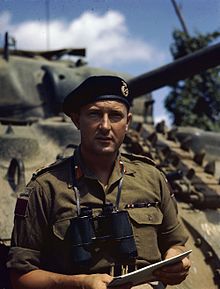 Bertram Meryl Hoffmeister was born in Vancouver, British Columbia. He was a sales manager with Canadian White Pine (Forestry company).
Bertram Meryl Hoffmeister was born in Vancouver, British Columbia. He was a sales manager with Canadian White Pine (Forestry company).
Bert Hoffmeister started his military career when he joined the Seaforth Highlanders Cadets Corps when 12 years old. He joined the Seaforth Highlanders in 1927 and by 1939, he was commanding a company as a Major.
He went with his regiment to England but was sent back to Canadian March 1942, to attend the Canadian Junior War Staff College. courses at the Royal Military College in Kingston, Ontario. After graduation, he was promoted Lt-Col and returned to Europe to command the Seaforth Highlanders.
He was awarded his first DSO while fighting in Sicily. By October 1943, Hoffmeister became Brigadier and commanding officer of the 2nd Canadian Infantry Brigade. His brigade was tasked with the taking of the town of Ortona, in December 1943.
On March 20th, 1944, Hoffmeister was promoted Major General and took command of the 5th Canadian Armoured Division, He commanded the division through Italy and Northwest Europe.
After the war, Bert Hoffmeister resumed his business activities in the forest industry. He was CEO of MacMillan Bloedel from 1949 to 1957.
The 6th, 7th, 8th Divisions were raised in Canada for Home Defense. They each contained 3 Infantry Brigades plus supporting units.
6th Division existed from 18 March 1942 until 31 January 1945 and its area of operations was the Pacific Coast
The 7th Division existed from 12 May 1942 until 15 October 1943 and its area of operations was the Maritimes.
The 8th Division existed from 15 June 1942 until 15 October 1942 and its area of operations was the Pacific Coast.
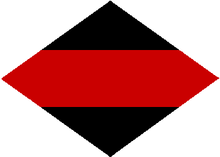
1st Canadian Army Tank Brigade
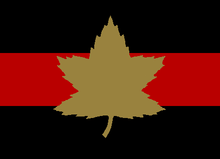
This unit starts life as the 1st Canadian Army Tank Brigade on 27 February 1941. It is quickly authorized and put together as a response to the successful use of armour by the Germans in the Lowlands and France.
The Brigade went overseas in July 1941.
The Calgary Regiment was tasked to supply armoured support to the Dieppe raid with their Churchill tanks. Of the 417 who were part of the operation, 12 (including the commanding officer) were killed and 161 captured. 30 tanks were also lost (all that were landed).
Sicily was the next operation where Three Rivers Regiment support the 1st Canadian Infantry Division. The rest of the brigade landed later and were attached to the British 13 Corps and then into the 8th Army Reserve. The brigade was reformed on 11August 1943.
The brigade was renamed 1st Canadian Armoured Brigade on 26th August 1943 and the Tank Battalions became Armoured Regiments with the same serial numbers..
The brigade landed in Italy in September 1943 and supported the Canadian Infantry.
The brigade rejoined 1st Canadian Army in early 1945.
Commanders

Major-General Frederic Franklin "Worthy" Worthington, MC, MM, CD (September 17, 1889–December 8, 1967)
For an in-depth biography of Worthington, Click Here.
Worthington was born in Peterhead, Scotland. His family emigrated to California in the early 1900s. When he was 10, his parents died and he moved to Mexico to live with his brother. When his brother was killed, he found work as a cabin boy.
His military career began as a mercenary leading a Gatling Gun team for Nicaragua. When Nicaragua lost, he escaped and went back to sea. Later, he attempted Gun Running to Cuba and in 1913 fought for Madero during the Mexican Civil War - where he was wounded.
World War 1 saw him attempting to get to Scotland to join the Black Watch. Upon arriving in Montreal, he saw a soldier in a kilt and joined up with Royal Highlanders of Canada (Black Watch). He went to World War 1 with the 73rd Battalion (Royal Highlanders of Canada).
Worthington was awarded his Military Medal on 12 March 1917 for actions on 7 January 1917 (Holds off a German raiding party with his machine gun) and the Bar on 9 July 1917 (For actions on 9-11 April 1917 at the Battle of Arras (Battle of the Scarpe)).
Worthington was awarded the Military Cross on 1 February 1919 for actions on 2 September 1918 near Villers France ( conspicuous gallantry leading his battery in open combat) and the Bar on 2 April 1919.
Worthington is wounded in April 1919 and sent to England. While he is recuperating, the 73rd is disbanded. Upon getting out of the hospital, Worthington takes his officer's course and then a machine gun course in order to become a battery commander with 18th Machine Gun Company.
Worthington served in the Canadian Machine Gun Corps in 1917. He was awarded the Military Medal for actions near Vimy Ridge, on 6 January 1917 for holding his position during a German advance.
After the First World War, he stayed in the military first with the Canadian Machine Gun Corps and then with the PPCLI. He was known to be a proponent of armoured fighting vehicles.
After taking courses in England, Worthington is the first commander of the first Armoured Training school in Canada. When the Canadian Armoured Corps was created in 13 August 1949 - he was the first commander.
Worthington organized the 1st Canadian Tank Brigade (later the 1st Canadian Armoured Brigade, an independent formation) and also converted the 4th Canadian Infantry Division to an armoured division in only five months.
In 1944, Worthy was forced to relinquish command of the 4th Armoured Division, "officially" due to poor health,
He returned to Camp Borden, where replacements were trained for the Canadian Armoured Corps and Infantry, as well as the Royal Canadian Army Service Corps and the Canadian Provost Corps.
Worthington served as General Officer Commander in Chief of Pacific Command from 1 April 1945 to 26 January 1946. Later he was appointed the first Colonel-Commandant of the Royal Canadian Armoured Corps and of the Canadian Rangers..

Brigadier Robert Andrew Wyman (23 February 1904 1967)
1939-09-04 – 1939-12-21 Commanding Officer 3rd Field Brigade Royal Canadian Artillery
1939-12-21 – 1941-04-14 Commanding Officer 3rd Field Regiment Royal Canadian Artillery
1941-05-18 – 1942-02-01 Commanding Officer 1st Canadian Support Group
1942-02-02 – 1943-08-26 Commanding Officer 1st Canadian Army Tank Brigade [England] - Sicily
1943-08-26 – 1944-02-26 Commanding Officer 1st Canadian Armoured Brigade, Sicily - Italy
1944-02-27 – 1944-04-14 Brigadier Royal Armoured Corps 1st Canadian Army [England] - This was a liaison position between the Army and any British Armour Corps units
1944-04-15 – 1944-08-08 Commanding Officer 2nd Canadian Armoured Brigade [England]
1944-XX-XX Commanding Officer 9th Canadian Brigade [England]

Brigadier William Cameron Murphy (1905 - 1961)rew Wyman (23 February 1904 1967)
1943-05-06 – 1944-02-26 General Staff Officer 1 5th Canadian Armoured Division [Italy]
1944-02-27 – 1945-06-25 Commanding Officer 1st Canadian Armoured Brigade [England]
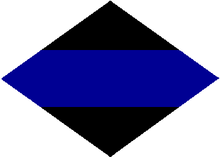
2nd Canadian Army Tank Brigade
2nd Canadian Armoured Brigade (after June 1943)

This unit is authorized as the 2nd Canadian Army Tank Brigade on 26 January 1942. It is formed using three infantry units that became extra when the 4th Infantry Division became the 4th Armoured Division.
The three units converted from infantry to Army Tank Battalions in early 1940.
The Brigade went overseas in June 1943. Once in the UK, it was determined that three Army Tank Battalions were surplus to need and only two were required.
3CATB was considered better trained and more experienced due to the units being trained in England for the past two years and more often with the infantry divisions.
All of the Army Tank Battalions from both 2 and 3 Army Tank Brigades were inspected by Lt-Gen H. Crerar (Commander, I Canadian Corps) and the top three were retained. This lead to the disbanding of 3 CATB with all three of its battalions moving to 2nd Canadian Armoured Brigade and the Tank Battalions becoming Armoured Regiments. The original three battalions were disbanded by November of that year as in the intervening months; most of their strength was siphoned off as reinforcements to other Canadian Armoured Units..
In mid-1943, 2CAB was started training of a beach invasion and along with 3CIB – transferred to British command and training in Scotland. They also began working with Duplex Drive (or DD) amphibious M4 Sherman tanks.
On D-Day, the 1st Hussars and the Fort Garry Horse landed as assault units providing close support to the infantry.
The rest of the war was spent supporting both 2CID and 3CID.
.
Commanders

Brigadier Norman Angelo Gianelli (1895 - 1974)
1940-07-06 – 1940-09-20 Commanding Officer Lord Strathcona's Horse
1940-09-21 – 1942-09-21 Commanding Officer 2nd Canadian Armoured Regiment
1942-09-22 – 1943-06-11 Commanding Officer 2nd Canadian Army Tank Brigade [England]
1943-06-12 – 1943-07-21 Commanding Officer 3rd Canadian Army Tank Brigade [England] - Relieved as he was considered too old.
1943-07-22 – 1944-03-23 Commanding Officer 2nd Canadian Armoured Brigade
1944-XX-XX Commanding Officer Group E Canadian Reinforcement Units [England]
1944-XX-XX Acting Brigadier Royal Armour Coprs 1st Canadian Army [England] - This was a liaison position.
He left the military after the war.
1944-04-21 – 1944-12-08 Brigadier Royal Armoured Corps 1st Canadian Army

Brigadier Robert Andrew Wyman (23 February 1904 1967)
1939-09-04 – 1939-12-21 Commanding Officer 3rd Field Brigade Royal Canadian Artillery
1939-12-21 – 1941-04-14 Commanding Officer 3rd Field Regiment Royal Canadian Artillery
1941-05-18 – 1942-02-01 Commanding Officer 1st Canadian Support Group
1942-02-02 – 1943-08-26 Commanding Officer 1st Canadian Army Tank Brigade [England] - Sicily
1943-08-26 – 1944-02-26 Commanding Officer 1st Canadian Armoured Brigade, Sicily - Italy
1944-02-27 – 1944-04-14 Brigadier Royal Armoured Corps 1st Canadian Army [England] - This was a liaison position between the Army and any British Armour Corps units
1944-04-15 – 1944-08-08 Commanding Officer 2nd Canadian Armoured Brigade [England]
1944-XX-XX Commanding Officer 9th Canadian Brigade [England]

Brigadier John Francis Bingham (1911 - 1989)
1942-06-29 – 1944-02-13 Commanding Officer 1st Battalion Royal Canadian Dragoons
1944-02-14 – 1944-03-23 Commanding Officer 12th Canadian Armoured Regiment
1944 Second in Command 2nd Canadian Armoured Brigade [England]
1944-08-09 – 1944-12-08 Commanding Officer 2nd Canadian Armoured Brigade [England]
1944-12-09 – 1945-07-30 Brigadier Royal Armoured Corps 1st Canadian Army, North-West Europe
1945 – 1946Commandant of A-33 Canadian Army Cadet Training Establishment at Camp Borden
1946 – 1947 Director of Royal Canadian Army Cadets
1947 – 1948 Military Attaché to Turkey
1949 Retired

BrigadierG. W. Robinson
If you have any information on this person, please share with the museum by emailing the webmaster. Thank you.
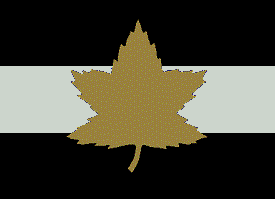
3rd Canadian Army Tank Brigade
3CATB was created in January 1943 as a temporary holding unit when the Canadian Armoured Divisions changed from two armoured brigades to one. This reorganization took place in the UK.
In June 1943, 2CATB arrived in the UK and it was determined that three Army Tank Battalions were surplus to need and only two were required.
3CATB was considered better trained and more experienced due to the units being trained in England for the past two years more often with the infantry divisions.
All of the Army Tank Battalions from both 2 and 3 Army Tank Brigades were inspected by Lt-Gen H. Crerar (Commander I Canadian Corp) and the top three were retained. This lead to the disbanding of 3 CATB with all of its three battalions moving to 2nd Canadian Armoured Brigade with the Tank Battalions becoming Armoured Regiments.
The original 2CATB units were transferred to 3CATB and their members used for reinforcements for other armoured units until their strength was reduce to essential nothing by November of that year.
3CATB was then disbanded.
Commanders
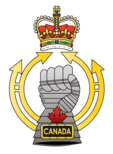
By using this site, you agree to our terms and conditions.
Terms and Conditions.
Copyright
Contact us by email.
© 2020 Royal Canadian Armoured Corps Association
